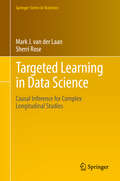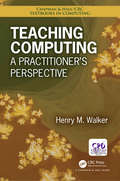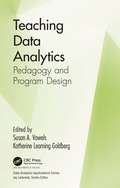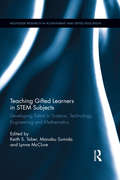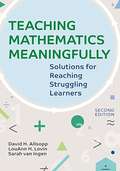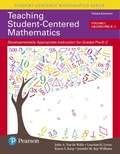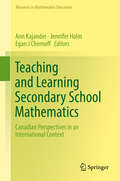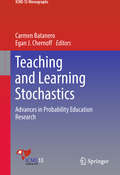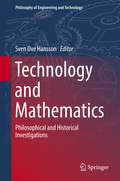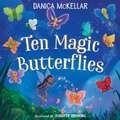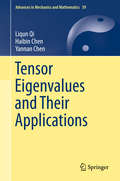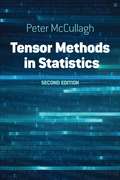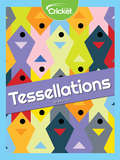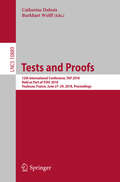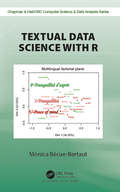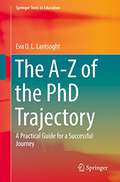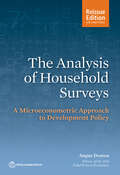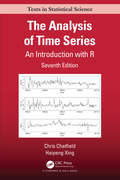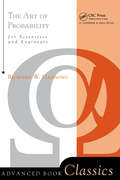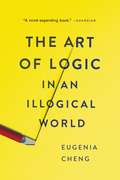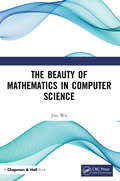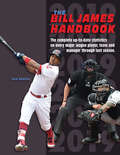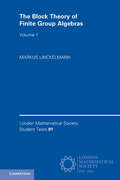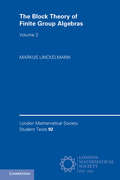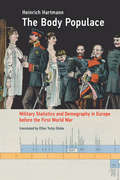- Table View
- List View
Targeted Learning in Data Science: Causal Inference For Complex Longitudinal Studies (Springer Series in Statistics)
by Mark J. van der Laan Sherri RoseThis textbook for graduate students in statistics, data science, and public health deals with the practical challenges that come with big, complex, and dynamic data. It presents a scientific roadmap to translate real-world data science applications into formal statistical estimation problems by using the general template of targeted maximum likelihood estimators. These targeted machine learning algorithms estimate quantities of interest while still providing valid inference. Targeted learning methods within data science area critical component for solving scientific problems in the modern age. The techniques can answer complex questions including optimal rules for assigning treatment based on longitudinal data with time-dependent confounding, as well as other estimands in dependent data structures, such as networks. Included in Targeted Learning in Data Science are demonstrations with soft ware packages and real data sets that present a case that targeted learning is crucial for the next generation of statisticians and data scientists. Th is book is a sequel to the first textbook on machine learning for causal inference, Targeted Learning, published in 2011.Mark van der Laan, PhD, is Jiann-Ping Hsu/Karl E. Peace Professor of Biostatistics and Statistics at UC Berkeley. His research interests include statistical methods in genomics, survival analysis, censored data, machine learning, semiparametric models, causal inference, and targeted learning. Dr. van der Laan received the 2004 Mortimer Spiegelman Award, the 2005 Van Dantzig Award, the 2005 COPSS Snedecor Award, the 2005 COPSS Presidential Award, and has graduated over 40 PhD students in biostatistics and statistics.Sherri Rose, PhD, is Associate Professor of Health Care Policy (Biostatistics) at Harvard Medical School. Her work is centered on developing and integrating innovative statistical approaches to advance human health. Dr. Rose’s methodological research focuses on nonparametric machine learning for causal inference and prediction. She co-leads the Health Policy Data Science Lab and currently serves as an associate editor for the Journal of the American Statistical Association and Biostatistics.
Teaching Computing: A Practitioner's Perspective
by Henry M. WalkerTeaching can be intimidating for beginning faculty. Some graduate schools and some computing faculty provide guidance and mentoring, but many do not. Often, a new faculty member is assigned to teach a course, with little guidance, input, or feedback. Teaching Computing: A Practitioner’s Perspective addresses such challenges by providing a solid resource for both new and experienced computing faculty. The book serves as a practical, easy-to-use resource, covering a wide range of topics in a collection of focused down-to-earth chapters. Based on the authors’ extensive teaching experience and his teaching-oriented columns that span 20 years, and informed by computing-education research, the book provides numerous elements that are designed to connect with teaching practitioners, including: A wide range of teaching topics and basic elements of teaching, including tips and techniques Practical tone; the book serves as a down-to-earth practitioners’ guide Short, focused chapters Coherent and convenient organization Mix of general educational perspectives and computing-specific elements Connections between teaching in general and teaching computing Both historical and contemporary perspectives This book presents practical approaches, tips, and techniques that provide a strong starting place for new computing faculty and perspectives for reflection by seasoned faculty wishing to freshen their own teaching.
Teaching Data Analytics: Pedagogy and Program Design (Data Analytics Applications)
by Susan A Vowels Katherine Leaming GoldbergThe need for analytics skills is a source of the burgeoning growth in the number of analytics and decision science programs in higher education developed to feed the need for capable employees in this area. The very size and continuing growth of this need means that there is still space for new program development. Schools wishing to pursue business analytics programs intentionally assess the maturity level of their programs and take steps to close the gap. Teaching Data Analytics: Pedagogy and Program Design is a reference for faculty and administrators seeking direction about adding or enhancing analytics offerings at their institutions. It provides guidance by examining best practices from the perspectives of faculty and practitioners. By emphasizing the connection of data analytics to organizational success, it reviews the position of analytics and decision science programs in higher education, and to review the critical connection between this area of study and career opportunities. The book features: A variety of perspectives ranging from the scholarly theoretical to the practitioner applied An in-depth look into a wide breadth of skills from closely technology-focused to robustly soft human connection skills Resources for existing faculty to acquire and maintain additional analytics-relevant skills that can enrich their current course offerings. Acknowledging the dichotomy between data analytics and data science, this book emphasizes data analytics rather than data science, although the book does touch upon the data science realm. Starting with industry perspectives, the book covers the applied world of data analytics, covering necessary skills and applications, as well as developing compelling visualizations. It then dives into pedagogical and program design approaches in data analytics education and concludes with ideas for program design tactics. This reference is a launching point for discussions about how to connect industry’s need for skilled data analysts to higher education’s need to design a rigorous curriculum that promotes student critical thinking, communication, and ethical skills. It also provides insight into adding new elements to existing data analytics courses and for taking the next step in adding data analytics offerings, whether it be incorporating additional analytics assignments into existing courses, offering one course designed for undergraduates, or an integrated program designed for graduate students.
Teaching Gifted Learners in STEM Subjects: Developing Talent in Science, Technology, Engineering and Mathematics (Routledge Research in Achievement and Gifted Education)
by Keith S. Taber Manabu Sumida Lynne McClureThis book offers an overview of programmes designed to support the learning of gifted and talented students in STEM subjects, both to allow them to meet their potential and to encourage them to proceed towards careers in STEM areas. The chapters from a range of national contexts report on perspectives, approaches and projects in gifted education in STEM subjects. These contributions provide a picture of the state of research and practice in this area, both to inform further research and development, and to support classroom teachers in their day-to-day work. Chapters have been written with practitioners in mind, but include relevant scholarly citations to the literature. The book includes some contributions illustrating research and practice in specific STEM areas, and others which bridge across different STEM subjects. The volume also includes an introductory theoretical chapter exploring the implications for gifted learners of how 'STEM' is understood and organized within the school curriculums.
Teaching Mathematics Meaningfully: Solutions for Reaching Struggling Learners
by LouAnn Lovin David Allsopp Sarah Van IngenIn the new edition of Teaching Mathematics Meaningfully, the authors have incorporated current research, aligned concepts and practices with the Common Core State Standards and NCTM teaching practices, explained learning trajectories in mathematics, and discussed how to use their instructional process within RTI/MTSS. Based on a foundation of identifying and understanding the Mathematics, the authors’ conceptual framework integrates continuous assessment and two perspectives, math learning needs and the learning needs of struggling learners, to plan and implement responsive instruction.
Teaching Student-centered Mathematics
by John A. Van de Walle Jennifer M. Bay-Williams Karen Karp LouAnn LovinHelping students make connections between mathematics and their worlds-and helping them feel empowered to use math in their lives-is the focus of this widely popular guide. Designed for classroom teachers, the book focuses on specific grade bands and includes information on creating an effective classroom environment, aligning teaching to various standards and practices, such as the Common Core State Standards and NCTM's teaching practices, and engaging families. The first portion of the book addresses how to build a student-centered environment in which children can become mathematically proficient, while the second portion focuses on practical ways to teach important concepts in a student-centered fashion. The new edition features a corresponding Enhanced Pearson eText version with links to embedded videos, blackline masters, downloadable teacher resource and activity pages, lesson plans, activities correlated to the CCSS, and tables of common errors and misconceptions. <p><p> This book is part of the Student-Centered Mathematics Series, which is designed with three objectives: to illustrate what it means to teach student-centered, problem-based mathematics, to serve as a reference for the mathematics content and research-based instructional strategies suggested for the specific grade levels, and to present a large collection of high quality tasks and activities that can engage students in the mathematics that is important for them to learn.
Teaching and Learning Secondary School Mathematics: Canadian Perspectives in an International Context (Advances in Mathematics Education)
by Jennifer Holm Ann Kajander Egan J ChernoffThis volume brings together recent research and commentary in secondary school mathematics from a breadth of contemporary Canadian and International researchers and educators. It is both representative of mathematics education generally, as well as unique to the particular geography and culture of Canada. The chapters address topics of broad applicability such as technology in learning mathematics, recent interest in social justice contexts in the learning of mathematics, as well as Indigenous education. The voices of classroom practitioners, the group ultimately responsible for implementing this new vision of mathematics teaching and learning, are not forgotten. Each section includes a chapter written by a classroom teacher, making this volume unique in its approach. We have much to learn from one another, and this volume takes the stance that the development of a united vision, supported by both research and professional dialog, provides the first step.
Teaching and Learning Stochastics: Advances In Probability Education Research (ICME-13 Monographs)
by Carmen Batanero Egan J ChernoffThis book presents a collection of selected papers that represent the current variety of research on the teaching and learning of probability. The respective chapters address a diverse range of theoretical, empirical and practical aspects underpinning the teaching and learning of probability, curricular issues, probabilistic reasoning, misconceptions and biases, as well as their pedagogical implications. These chapters are divided into THREE main sections, dealing with: TEACHING PROBABILITY, STUDENTS' REASONING AND LEARNING AND EDUCATION OF TEACHERS.In brief, the papers presented here include research dealing with teachers and students at different levels and ages (from primary school to university) and address epistemological and curricular analysis, as well as the role of technology, simulations, language and visualisation in teaching and learning probability. As such, it offers essential information for teachers, researchers and curricular designers alike.
Technology and Mathematics: Philosophical and Historical Investigations (Philosophy of Engineering and Technology #30)
by Sven Ove HanssonThis volume is the first extensive study of the historical and philosophical connections between technology and mathematics. Coverage includes the use of mathematics in ancient as well as modern technology, devices and machines for computation, cryptology, mathematics in technological education, the epistemology of computer-mediated proofs, and the relationship between technological and mathematical computability. The book also examines the work of such historical figures as Gottfried Wilhelm Leibniz, Charles Babbage, Ada Lovelace, and Alan Turing.
Ten Magic Butterflies (McKellar Math)
by Danica McKellarLearn at home with help from The Wonder Years/Hallmark actress, math whiz, and New York Times bestselling author Danica McKellar using her acclaimed McKellar Math books! Fairies, butterflies, and magic help to make this math-focused picture book positively enchanting! Join ten flower friends for a night of excitement that mixes a little math with a lot of magic. As each flower turns into a butterfly, children will discover different ways to group numbers to create ten, an essential building block of math, all while watching each flower's dream come true. (And keep an eye out for the adorable caterpillar who wishes he could fly, too!) In this, the second book in the McKellar Math line, actress, math whiz, and New York Times bestselling author Danica McKellar once again sneaks in secret addition and subtraction concepts to help make your child smarter and uses her proven math success to show children that loving numbers is as easy as a wave of a wand and a BING BANG BOO! "[Danica McKellar's] bringing her love of numbers to children everywhere." --Brightly on Goodnight, Numbers "Danica McKellar is now on a mission to make math fun for even the youngest of kids." --L.A. Parent Magazine
Tensor Eigenvalues and Their Applications (Advances in Mechanics and Mathematics #39)
by Liqun Qi Haibin Chen Yannan ChenThis book offers an introduction to applications prompted by tensor analysis, especially by the spectral tensor theory developed in recent years. It covers applications of tensor eigenvalues in multilinear systems, exponential data fitting, tensor complementarity problems, and tensor eigenvalue complementarity problems. It also addresses higher-order diffusion tensor imaging, third-order symmetric and traceless tensors in liquid crystals, piezoelectric tensors, strong ellipticity for elasticity tensors, and higher-order tensors in quantum physics. This book is a valuable reference resource for researchers and graduate students who are interested in applications of tensor eigenvalues.
Tensor Methods in Statistics: Second Edition
by Peter McCullaghA pioneering monograph on tensor methods applied to distributional problems arising in statistics, this work constitutes a valuable reference for graduate students and professional statisticians. Prerequisites include some knowledge of linear algebra, eigenvalue decompositions, and linear models as well as likelihood functions and likelihood ratio statistics. Index notation is the favored mode of expression throughout the book. The first chapter introduces a number of aspects of index notation, groups, invariants, and tensor calculus, with examples drawn from linear algebra, physics, and statistics. Subsequent chapters form the core of the text, addressing moments, cumulants, and invariants. Additional topics include sample cumulants, Edgeworth series, saddlepoint approximation, likelihood functions, and ancillary statistics. More than 200 exercises form an integral part of the text.
Tessellations
by Amy TaoPatterns are an important and often beautiful part of our world. One such pattern is a tessellation, or a series of shapes that is arranged in a manner that repeats itself with no gaps. Learn how to make your own tessellation with a fun craft!
Tests and Proofs: 12th International Conference, TAP 2018, Held as Part of STAF 2018, Toulouse, France, June 27-29, 2018, Proceedings (Lecture Notes in Computer Science #10889)
by Catherine Dubois Burkhart WolffThis book constitutes the refereed proceedings of the 12th International Conference on Tests and Proofs, TAP 2018, held as part of STAF 2018, in Toulouse, France, in June 2018. The 8 regular papers, 2 short papers, 1 invited paper and 1 invited tutorial presented in this volume were carefully reviewed and selected from 18 submissions. The TAP conference promotes research in verification and formal methods that targets the interplay of proofs and testing: the advancement of techniques of each kind and their combination, with the ultimate goal of improving software and system dependability.
Textual Data Science with R (Chapman & Hall/CRC Computer Science & Data Analysis)
by Mónica Bécue-BertautTextual Statistics with R comprehensively covers the main multidimensional methods in textual statistics supported by a specially-written package in R. Methods discussed include correspondence analysis, clustering, and multiple factor analysis for contigency tables. Each method is illuminated by applications. The book is aimed at researchers and students in statistics, social sciences, hiistory, literature and linguistics. The book will be of interest to anyone from practitioners needing to extract information from texts to students in the field of massive data, where the ability to process textual data is becoming essential.
The A-Z of the PhD Trajectory: A Practical Guide for a Successful Journey (Springer Texts In Education)
by Eva O. L. LantsoghtIs suitable for a classroom setting as well as for self-study.<P><P> Offers advice, anecdotes and exercises to teach junior PhD students in STEM how to succeed.<P> Provides information and suggested methods for all steps of the PhD trajectory.<P> Contains an extensive glossary of terms.<P>This textbook is a guide to success during the PhD trajectory. The first part of this book takes the reader through all steps of the PhD trajectory, and the second part contains a unique glossary of terms and explanation relevant for PhD candidates. Written in the accessible language of the PhD Talk blogs, the book contains a great deal of practical advice for carrying out research, and presenting one’s work. It includes tips and advice from current and former PhD candidates, thus representing a broad range of opinions. The book includes exercises that help PhD candidates get their work kick-started. It covers all steps of a doctoral journey in STEM: getting started in a program, planning the work, the literature review, the research question, experimental work, writing, presenting, online tools, presenting at one’s first conference, writing the first journal paper, writing and defending the thesis, and the career after the PhD. Since a PhD trajectory is a deeply personal journey, this book suggests methods PhD candidates can try out, and teaches them how to figure out for themselves which proposed methods work for them, and how to find their own way of doing things.
The Analysis of Household Surveys: A Microeconometric Approach to Development Policy (World Bank Ser.)
by Angus DeatonTwo decades after its original publication, The Analysis of Household Surveys is reissued with a new preface by its author, Sir Angus Deaton, recipient of the 2015 Nobel Prize in Economic Sciences. This classic work remains relevant to anyone with a serious interest in using household survey data to shed light on policy issues. The book reviews the analysis of household survey data, including the construction of household surveys, the econometric tools useful for such analysis, and a range of problems in development policy for which this survey analysis can be applied. Chapter 1 describes the features of survey design that need to be understood in order to undertake appropriate analysis. Chapter 2 discusses the general econometric and statistical issues that arise when using survey data for estimation and inference. Chapter 3 covers the use of survey data to measure welfare, poverty, and distribution. Chapter 4 focuses on the use of household budget data to explore patterns of household demand. Chapter 5 discusses price reform, its effects on equity and efficiency, and how to measure them. Chapter 6 addresses the role of household consumption and saving in economic development. The book includes an appendix providing code and programs using STATA, which can serve as a template for users' own analysis.
The Analysis of Time Series: An Introduction with R (Chapman & Hall/CRC Texts in Statistical Science)
by Chris Chatfield Haipeng XingThis new edition of this classic title, now in its seventh edition, presents a balanced and comprehensive introduction to the theory, implementation, and practice of time series analysis. The book covers a wide range of topics, including ARIMA models, forecasting methods, spectral analysis, linear systems, state-space models, the Kalman filters, nonlinear models, volatility models, and multivariate models.
The Art Of Probability: For Scientists And Engineers
by Richard W. HammingOffering accessible and nuanced coverage, Richard W. Hamming discusses theories of probability with unique clarity and depth. Topics covered include the basic philosophical assumptions, the nature of stochastic methods, and Shannon entropy. One of the best introductions to the topic, The Art of Probability is filled with unique insights and tricks worth knowing.
The Art of Logic in an Illogical World: The Art Of Logic In An Illogical World
by Eugenia ChengHow both logical and emotional reasoning can help us live better in our post-truth worldIn a world where fake news stories change election outcomes, has rationality become futile? In The Art of Logic in an Illogical World, Eugenia Cheng throws a lifeline to readers drowning in the illogic of contemporary life. Cheng is a mathematician, so she knows how to make an airtight argument. But even for her, logic sometimes falls prey to emotion, which is why she still fears flying and eats more cookies than she should. If a mathematician can't be logical, what are we to do? In this book, Cheng reveals the inner workings and limitations of logic, and explains why alogic--for example, emotion--is vital to how we think and communicate. Cheng shows us how to use logic and alogic together to navigate a world awash in bigotry, mansplaining, and manipulative memes. Insightful, useful, and funny, this essential book is for anyone who wants to think more clearly.
The Beauty of Mathematics in Computer Science
by Jun WuThe Beauty of Mathematics in Computer Science explains the mathematical fundamentals of information technology products and services we use every day, from Google Web Search to GPS Navigation, and from speech recognition to CDMA mobile services. The book was published in Chinese in 2011 and has sold more than 600,000 copies. Readers were surprised to find that many daily-used IT technologies were so tightly tied to mathematical principles. For example, the automatic classification of news articles uses the cosine law taught in high school. The book covers many topics related to computer applications and applied mathematics including: Natural language processing Speech recognition and machine translation Statistical language modeling Quantitive measurement of information Graph theory and web crawler Pagerank for web search Matrix operation and document classification Mathematical background of big data Neural networks and Google’s deep learning Jun Wu was a staff research scientist in Google who invented Google’s Chinese, Japanese, and Korean Web Search Algorithms and was responsible for many Google machine learning projects. He wrote official blogs introducing Google technologies behind its products in very simple languages for Chinese Internet users from 2006-2010. The blogs had more than 2 million followers. Wu received PhD in computer science from Johns Hopkins University and has been working on speech recognition and natural language processing for more than 20 years. He was one of the earliest engineers of Google, managed many products of the company, and was awarded 19 US patents during his 10-year tenure there. Wu became a full-time VC investor and co-founded Amino Capital in Palo Alto in 2014 and is the author of eight books.
The Bill James Handbook 2019
by Bill James Baseball Info SolutionsBill James and Baseball Info Solutions team of analysts continue to pack in new content, including a fresh look at the continues rise and effectiveness of The Shift and a new breakdown of home runs and long flyouts. And, as always, the book forecasts fresh hitter and pitcher projections for those looking to get an early jump on the next season.</
The Block Theory of Finite Group Algebras: Volume 1 (London Mathematical Society Student Texts #91)
by Markus LinckelmannThis is a comprehensive introduction to the modular representation theory of finite groups, with an emphasis on block theory. The two volumes take into account classical results and concepts as well as some of the modern developments in the area. Volume 1 introduces the broader context, starting with general properties of finite group algebras over commutative rings, moving on to some basics in character theory and the structure theory of algebras over complete discrete valuation rings. In Volume 2, blocks of finite group algebras over complete p-local rings take centre stage, and many key results which have not appeared in a book before are treated in detail. In order to illustrate the wide range of techniques in block theory, the book concludes with chapters classifying the source algebras of blocks with cyclic and Klein four defect groups, and relating these classifications to the open conjectures that drive block theory.
The Block Theory of Finite Group Algebras: Volume 2 (London Mathematical Society Student Texts #91)
by Markus LinckelmannThis is a comprehensive introduction to the modular representation theory of finite groups, with an emphasis on block theory. The two volumes take into account classical results and concepts as well as some of the modern developments in the area. Volume 1 introduces the broader context, starting with general properties of finite group algebras over commutative rings, moving on to some basics in character theory and the structure theory of algebras over complete discrete valuation rings. In Volume 2, blocks of finite group algebras over complete p-local rings take centre stage, and many key results which have not appeared in a book before are treated in detail. In order to illustrate the wide range of techniques in block theory, the book concludes with chapters classifying the source algebras of blocks with cyclic and Klein four defect groups, and relating these classifications to the open conjectures that drive block theory.
The Body Populace: Military Statistics and Demography in Europe before the First World War (Transformations: Studies in the History of Science and Technology)
by Heinrich HartmannHow data gathered from national conscriptions in pre–World War I Europe influenced understandings of population fitness and redefined society as a collective body. In pre–World War I Europe, individual fitness was increasingly related to building and preserving collective society. Army recruitment offered the most important opportunity to screen male citizens' fitness, raising questions of how to define fitness for soldiers and how to translate this criteria outside the military context. In this book, Heinrich Hartmann explores the historical circumstances that shaped collective understandings of fitness in Europe before World War I and how these were intertwined with a fear of demographic decline and degeneration. This dynamic gained momentum through the circulation of knowledge among European nations, but also through the scenarios of military confrontations. Hartmann provides a science history of military statistics in Germany, France, and Switzerland in the decades preceding World War I, considering how information gathered during national conscriptions generated data about the health and fitness of the population. Defined by masculine concepts, conscription examinations went far beyond the individuals they tested and measured. Scholars of the time aspired to pin down the “nation” in concrete numerical terms, drawing on data from examinations to redefine society as a “collective body” that could be counted, measured, and examined. The Body Populace explores the historical specificity and contingency of data-gathering techniques, recounts their uses and abuses, and provides a timely contribution to the growing historiography of Big Data. It sheds light on a crucial moment in nineteenth and early twentieth century European history—when statistical data and demographical knowledge shaped new notions of masculinity, fostered fears of degeneration, and gave rise to eugenic thinking.
